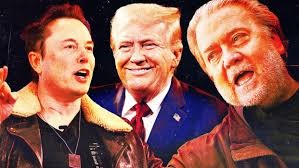Get the latest gossips in the world: Steve Bannon Aims to Remove Elon Musk from Trump Inner Circle Before Inauguration Day.
Steve Bannon has made the audacious political decision to cut off Elon Musk’s connections with former President Donald Trump’s inner circle before to Inauguration Day. Strongly opposing Musk’s influence on the Republican Party, Bannon, a pivotal member in Trump’s political movement, has called for measures to remove the tech tycoon from Trump’s inner circle.
As Bannon seeks to alter the dynamics of the party, this action coincides with escalating tensions inside political circles.
Steve Bannon recently called Elon Musk a “truly evil person” who has no true ideology other than a persistent pursuit of wealth in an interview with the Italian publication Corriere Della Sera. “Stopping him has become a personal issue,” Bannon continued, promising to get Musk cut out of Trump’s inner circle by Inauguration Day.
Read also: Laptops For Unmatched Performance and Value for Every Need in 2025
Steve Bannon Aims to Remove Elon Musk from Trump Inner Circle Before Inauguration Day
Bannon has a very severe reputation as a person who is well-known for his controversial beliefs and deeds. However, others may find his evaluation of Musk to be very perceptive. He maintained that Musk’s dealings with Trump were driven only by his desire to safeguard and grow his wealth. “In his quest for greater wealth, Musk will do whatever it takes to protect his businesses or to get better deals,” Bannon said.
He accused Musk of having no deeper ideological underpinnings, calling him a promoter of “techno-feudalism on a global scale” and stating that his sole objective was to become “a trillionaire.” Additionally, Bannon predicted that Musk would simply back down from any conflict, blaming the tech tycoon for lacking maturity.
Bannon and Musk appear to be on the verge of a major confrontation as the second Trump presidency approaches. According to a New York Times story, Musk is working on his “Department of Government Efficiency” (DOGE), a post that was formerly held by Bannon—that of Trump’s devoted ally. Although Musk touts DOGE on Twitter as a legitimate government organization, it appears to be more of a project that only exists in private Signal conversations with Silicon Valley leaders.
According to reports, Musk’s program wants tech executives to volunteer for six-month, unpaid positions that require 80-hour work weeks in order to offer recommendations on how to improve government processes. However, many have been turned off by the arrangement’s unpaid nature. DOGE’s future is still out in the air, but Trump has stated that he intends to go with it, albeit in a restricted capacity—making recommendations but not actually having the authority to implement change.
Trump and Musk’s relationship has been characterized as “tense,” and new reports suggest that Trump may be getting tired of Musk’s presence. During her appearance on Kara Swisher’s podcast, The New York Times reporter Maggie Haberman expressed her opinion that Musk was more inclined than others to annoy Trump, which could lead to additional pressure in their relationship.
Bannon may be trying to cut Musk out of Trump’s inner circle, but Musk doesn’t seem to be giving up easily. It’s difficult to forecast where Trump will be loyal because the dynamics in his environment are constantly changing. Musk gained Trump’s support during a previous spat over H-1B visas, but the tech tycoon may be losing his influence with the president.
Conclusion
Bannon’s ability to handle these power battles could be a significant advantage as Musk’s influence declines. However, it is unclear who will win in the end because both men ultimately represent opposing forces in a greater political conflict.
The continued divisions within Republican politics are highlighted by Bannon’s promise to cut Musk out of Trump’s inner circle. These power struggles might have long-term effects on Trump’s coalitions and the trajectory of his political dominance as the 2025 inauguration draws near.










